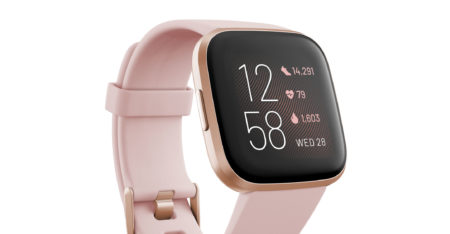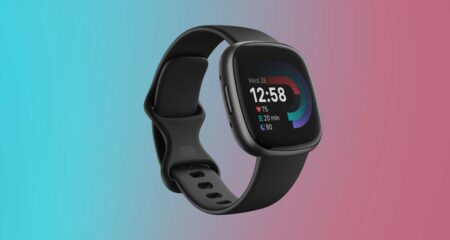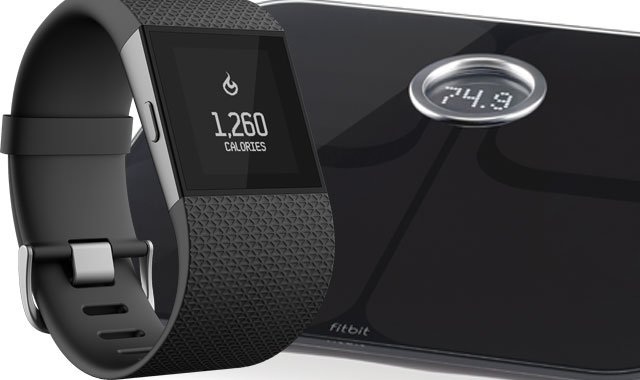
The Internet of things (IoT) has far-reaching applications in many spheres of business and consumer life, including the world of health and fitness.
Although many people may simply view the host of fitness and activity trackers as (an increasingly popular) means to record daily activity, or “gamify” exercise, these devices and — more importantly, the data they collect — have the potential to deliver so much more value to our lives.
This is because these wrist-based devices and the various other peripherals and apps that collect data and store and share it in the cloud are connecting our physical world with the virtual one created by computer systems.
This has given rise to the age of big data and human-computer interaction, where the idea of the “quantified self” has emerged. Although this concept has been around for more than 40 years in various forms, the practice of monitoring your body to gather data has now shifted from being characterised by the onerous manual recording of data — usually reserved for clinical and research settings — to an almost seamless integration into our lives.
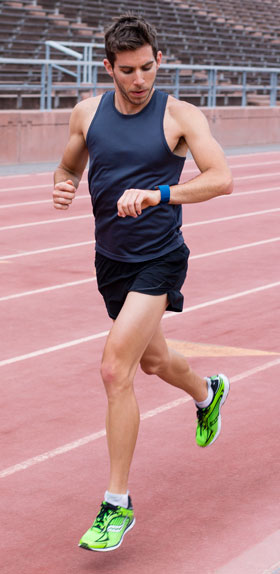 Research from GfK estimates 290% growth in the consumer wearables sector for 2015, with smartwatch sales set to grow from 4m units in 2014 to 26,1m units in 2015, and health and fitness trackers rising from 13,5m to 25m units.
Research from GfK estimates 290% growth in the consumer wearables sector for 2015, with smartwatch sales set to grow from 4m units in 2014 to 26,1m units in 2015, and health and fitness trackers rising from 13,5m to 25m units.
As sales soar, there’s a shift from the idea that IoT is predominantly about machine-to-machine communication. It’s about more than simply connecting the “thing” — the device — to the Internet. Rather, these devices are, in a manner of speaking, connecting humans to the Internet – call it the Internet of humans, or IoH.
The Fitbit experience
In this world — this meeting point between the human and the system — data is king, and the analytics that enable the interpretation of data sets are what deliver the greatest value, not necessarily the device itself.
There is one company that seems to have grasped this concept better than all the rest, at least in the consumer space, and that company is Fitbit.
Fitbit’s devices are good to look at, but they certainly aren’t at the cutting edge in terms of style and design. The company does, however, offer some of the most innovative products on the market.
After living with the recently released Fitbit Surge activity tracker and the Fitbit Aria Wi-Fi smart scale for almost two weeks, I can say confidently that everything within the Fitbit ecosystem is geared around collecting data and presenting it in the most user-friendly manner to give you a clear and concise “quantifiable” picture of yourself and your daily actions.
By the company’s own account: “Fitbit helps people lead healthier, more active lives by empowering them with data … to reach their goals.” When so much of the focus these days is on the device itself — its on-screen or in-device functionality, the way it looks, and its ability to connect to the Internet — this certainly strikes me as an important USP.
I was therefore eager to find out how the combination of the Fitbit Surge and Aria Wi-Fi scale, which I received to test from the local distributor, Core Group, would deepen my understanding of the way I live.
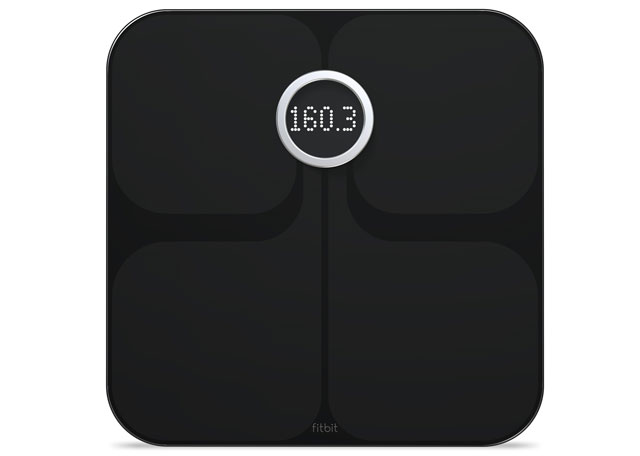
Smart Scale
The Fitbit Aria Wi-Fi Smart Scale is an attractive device that, with its polished glass surface, wouldn’t look out of place in the most modern of bathrooms. I received a black scale (there’s a white option, too), which has a round digital display embedded at the top.
It is considered a smart scale as it can measure your weight and body fat percentage, and determine body mass index (BMI — your body weight in kilograms divided by the square of your height in metres), and helps to determine a long-term view of your changing body composition by syncing wirelessly to your Fitbit account via Wi-Fi.
However, before it does that you have to set it up. That requires that you input details such as your height, age and name, among other info, into the Fitbit app and then sync your account with the scale.
During the initial set-up, I tried to do this using my iPhone 5s. However, this proved problematic when I was required to use the phone to try and establish the scale’s Wi-Fi connection. After some fussing about, I decided to download the plug-in for my MacBook and the setup was completed in minutes.
Having loaded my profile — denoted by my initials on the scale’s screen — all I had to do was jump on it and my metrics were measured. It can determine weight of between 9kg and 158kg, and the scale uses technology known as bioelectrical impedance testing to determine your body fat percentage.
This data is recorded and then sent automatically to your Fitbit account via the Wi-Fi connection. It was the epitome of seamless integration. The scale is also smart enough to recognise up to eight different profiles so that the entire family can share a single device. I was then able to access my data via the app or computer dashboard.
The scale runs off four standard 1,5V size AA batteries (included), so no power cord or power point was necessary.
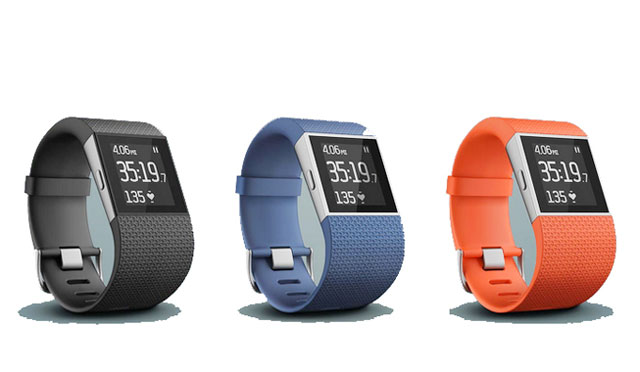
Watch functionality
With the scale set up and running smoothly, I turned my attention to the Fitbit Surge. It is the premium activity tracker in Fitbit’s extensive range, which includes the Fitbit Charge HR, Fitbit Charge, Fitbit Flex, Fitbit Zip and Fitbit One activity trackers. It is also the biggest, with a 1,25-inch LCD monochrome touchscreen display that is big enough to effectively function as an everyday watch.
Also, when considered in the context of a watch, it has a slim-ish form factor and it is light and has a quality rubber strap which meant it was comfortable to wear throughout the day and wasn’t bothersome to sleep with either. It is also available in extra large, large and small sizes. The black colour and understated design also make it a suitable accessory for any type of occasion outside of the gym.
There is some basic smartwatch-like functionality when paired with a companion device via Bluetooth as call and message notifications appear on the screen. There are no native apps available for the device and there is no social media integration so it can’t be considered a smartwatch.
You are able to control songs from your mobile device’s playlist, but that’s about the extent of the backward integration with your smartphone or tablet.
Strangely, in-device functionality is also rather limited and only seems to extend to managing exercise tracking, turning notifications on or off, toggling Bluetooth, setting the heart rate monitoring power options and turning the device on or off. This is done using a combination of the single button on the left to switch between screens and a combination of the two buttons on the right that are used to select inputs.
Everything else needs to done in the Fitbit app, which forms the focal point of the Fitbit ecosystem (more on this later). From the app you can change the watch face or set the silent alarm — a great feature for making sure you get up and out on those early morning runs without waking up the entire household.
That said, it is easy to navigate through the watch and activate the various sport tracking modes, and the initial setup through the app was quick and easy. Having inputted my details such as age, height, weight, and activity levels in the app, and a quick sync via Bluetooth, the daily activity tracking began automatically.
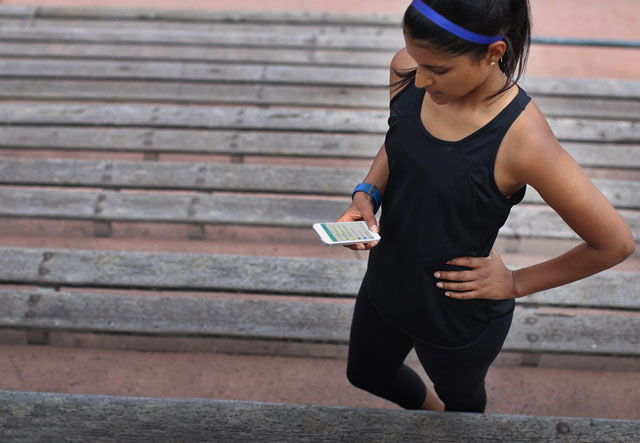
Activity tracking
In terms of daily activity tracking, the Surge tracks total steps, distance covered, calories burnt, floors climbed, elevation gained and active minutes thanks to the combination of a 3-axis accelerometer, a 3-axis gyroscope and an altimeter. Stats and progress can be easily viewed by swiping across the screen to toggle pages. These stats are also synced to the Fitbit app automatically when the app is opened.
The sleep tracking is also intuitive and automatic — no need to press a button or set the device to let it know that you are going to bed. I found it to be extremely accurate in determining when my head hit the pillow and when I woke up.
The other standout feature of the Surge, when compared to other activity trackers, is the GPS tracking functionality, which enables the device to more accurately record outdoor exercise such as running or cycling.
With both accelerometer and GPS capabilities, the multiple sport modes allow users to track and view workout summaries for activities with up to seven exercises that can be added to a device, including cycling, running, hiking, weight training, yoga, and bootcamp. Metrics such as distance, duration, average speed, current speed and top speed are recorded and can be viewed during a session on the device.
I found the user experience when setting off for a run to be quick and easy. The exercise mode menu is easy to access with a simple press of a button — no need to scroll through multiple menu items to find the activity type you’re about to engage in. The satellite lock was also quick — quicker than my Garmin Fenix 2, in fact.
Once a session is over, a summary of the data is shown on the screen and data is then uploaded to the Fitbit app for more detailed summaries when the app is opened.
While claimed battery life is up to seven days in basic daily activity tracking mode, and up to 10 hours in GPS mode, with regular use in GPS mode I was charging it every third day.

Continuous HR monitoring
The other important feature offered during all-day activity tracking and workout tracking, which I consider to be the most important, is the continuous wrist-based heart rate monitoring.
It is such a pivotal element missing from just about every other activity and fitness tracker out there except a handful such as the Mio Fuse, Garmin 225 or Vivoactive HR, and the Microsoft Band. This is because there is so much you can learn from tracking your heart rate throughout the day.
The feature, which first appeared in the Fitbit Charge HR, utilises Fitbit’s PurePulse optical heart rate technology with the flickering green LED lights located on the underside of the watch to measure changes in blood volume and determine your heart rate without the need to wear an uncomfortable chest strap.
This has been the missing piece in the activity tracking equation for me, and is one that has stopped me from buying a tracker in the past. However, with more devices being launched that offer this type of biofeedback, the depth and volume of information we can glean from activity trackers will grow exponentially.
Importantly, by tracking our heart rate throughout the day we can gain numerous insights into our state of health, from our rate of recovery and current fitness levels to general health and more accurate calorie expenditure data. With this we can determine if we are getting sick or are perhaps overtraining by tracking our resting (or waking) heart rate over time, or we can determine how our fitness levels are improving by determining our changing levels of heart rate variability.
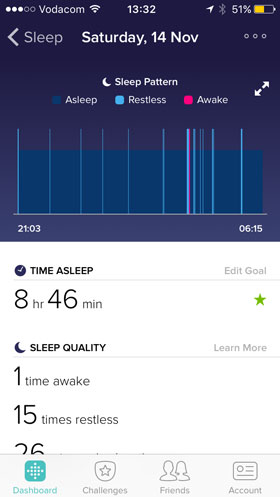 The central interface
The central interface
Of course, all this data is meaningless without the analytics to make sense of and interpret it, and that’s where the Fitbit app takes centre stage as it brings all this information to life.
It was definitely the stand-out feature for me with regard to the integrated Fitbit ecosystem as it’s the central hub where the, dare I say, “big data” is captured, analysed and presented in an easy-to-read and understand manner that enables us to quantify our everyday life and, to some extent, our state of health.
The free Fitbit app is compatible with more than 120 mobile devices that run on iOS, Android or Windows Mobile. As already mentioned, the app was required to set up the Surge and Aria scale initially, but once that was done it became the central user interface for all the data these devices were collecting.
Once the devices were set up, everything just worked. The integration with the app and the devices was seamless, creating an environment for what industry pundits term “low-friction data collection”. Whenever I opened the app, my sleep and daily activity data was synced automatically and updated on the well-designed dashboard. My body composition stats were also there, synced directly from the Aria scale to the cloud after my previous weigh-in.
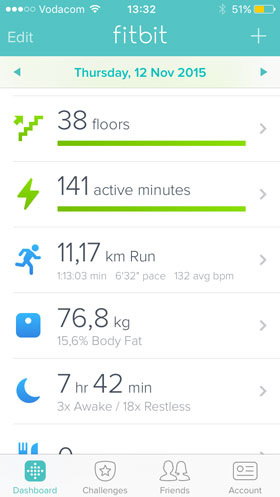 In the app, both graphic status bars and numeric updates make the data clear and concise to review. You can also click through to various metrics for more granular data. The sleep tracking, for example, offers an in depth analysis of your sleeping patterns, logging both duration and quality of sleep by tracking periods when you were either asleep, restless or awake. Total sleep quality is then determined against pre-set goals and rated accordingly. Sleep patterns are also graphically represented to show trends, and info on average sleep per night is also clearly visible in the feedback.
In the app, both graphic status bars and numeric updates make the data clear and concise to review. You can also click through to various metrics for more granular data. The sleep tracking, for example, offers an in depth analysis of your sleeping patterns, logging both duration and quality of sleep by tracking periods when you were either asleep, restless or awake. Total sleep quality is then determined against pre-set goals and rated accordingly. Sleep patterns are also graphically represented to show trends, and info on average sleep per night is also clearly visible in the feedback.
This can help to identify chronically poor sleeping patterns that may need attention from an expert. This info could also inform your approach to training or work after a poor night’s sleep as it would negatively impact your performance in the gym or office. By pushing hard following a night of sub-par sleep, you also increase your risk of injury, overtraining or may even weaken your immune system. With this depth of information, you’re empowered to make informed decisions that materially impact the quality of your health and your life.
In much the same way, daily activity and workout data are also presented in this detailed and granular manner, offering detailed summaries of how you measured up to your daily step goals or active minutes, for example. You can also manually log food and water consumption for even greater depth of in-app data about your daily habits.
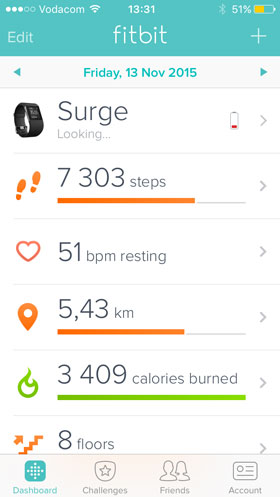 Additional stats and details, as well as more detailed graphs, are also available on the Web dashboard, which offers thorough mapping and elevation profiles, along with graphic representations of by-the-second views of speed, heart rate, heart rate zones and calorie expenditure for each ride or run.
Additional stats and details, as well as more detailed graphs, are also available on the Web dashboard, which offers thorough mapping and elevation profiles, along with graphic representations of by-the-second views of speed, heart rate, heart rate zones and calorie expenditure for each ride or run.
Virtual supporter
The app can also be used as a platform for motivation as you can challenge friends to some healthy competition by inviting them to join your leaderboard, where you can compare daily stats. You can also share your progress with friends and family via the dashboard, and earn badges to keep motivation levels up as you work toward your health and fitness goals.
Fitbit has also added additional layers of interaction to the experience as you receive on-screen notifications of progress toward set objectives or updates on the attainment of daily goals on your mobile device. You also get regular e-mail notifications and reminders, delivering a level of engagement I have not experienced when using other, similar systems.
Another point worth mentioning in this regard was the ease with which I was able to integrate my app with the Discovery Vitality system. It really was as simple as one click, and a whole new dimension was added to my connected fitness life. Again, once the initial setup was done, my data synced seamlessly with Vitality, where I was able to earn points towards my Vitality status. Discovery also gained more meaningful insight into the health status of one of their clients that their actuaries can hopefully use to improve their cover ratings or improve premiums — but the latter may just be wishful thinking.
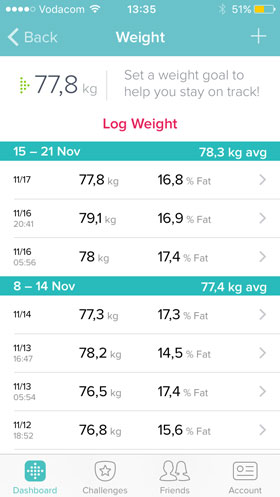 That does, however, bring this review full circle as we find ourselves discussing the application and potential of IoH and big data, which is being driven by devices such as the Fitbit Surge and Aria Smart Scale.
That does, however, bring this review full circle as we find ourselves discussing the application and potential of IoH and big data, which is being driven by devices such as the Fitbit Surge and Aria Smart Scale.
By creating these innovative health and fitness products and services that fit seamlessly into the lives of users, the company is making people more conscious of the way they’re living. This inspires people to make simple, more informed decisions to improve their lifestyle, and also gets them active to improve their health.
Furthermore, it is also laying the platform for a whole host of data-driven opportunities. For example, by collecting useful data about our health and activity levels and giving medical professionals access to this historic data, we may be able to drive a fundamental shift in the way modern medicine is practiced by moving from a reactive model to a proactive and preventative one. And that’s just one potential application of this type of technology.
The design and functionality of the Fitbit products I reviewed and the level of seamless integration the system offers gave me a glimpse into the potential that the connected and integrated world of IoH and big data offers.
Granted, not everyone wants this level of data analysis from their activity tracker or scale, but it is nice to know that the option is there from commercially available products like the Fitbit Surge (available from selected retailers for between R3 999 and R4 299) and the Aria Wi-Fi scale (available from various retailers for between R1 699 and R1 999).
It also gives us sports science geeks the ability to track and collate even more metrics and apply the information to our daily lives in an effort to boost recovery, manage weight and inform lifestyle decisions in the hope of enhancing our performance. It was certainly an intriguing and enlightening experience and I’m definitely considering making these devices permanent additions to my increasingly connected fitness-focused life. — © 2015 NewsCentral Media


